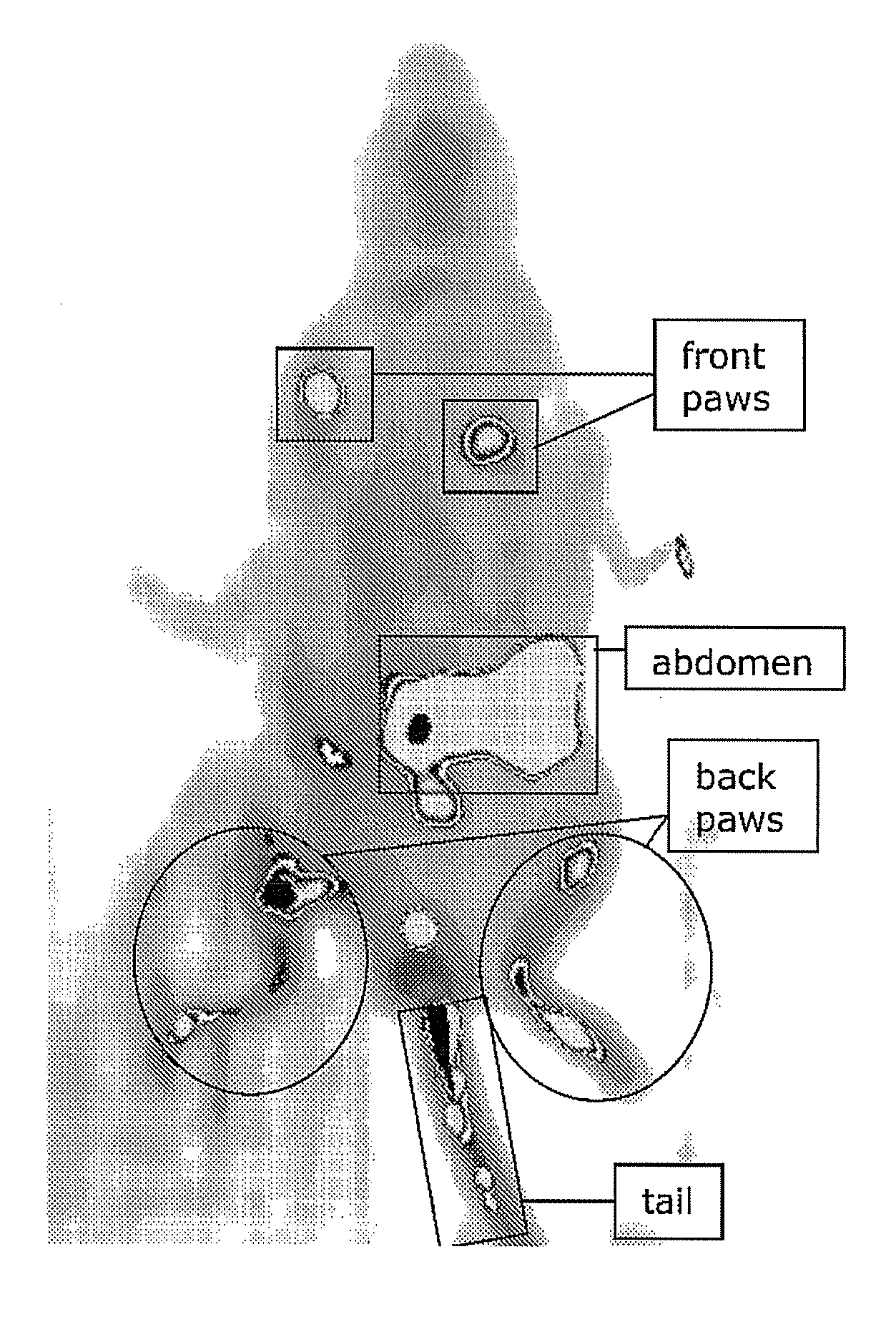Molecules for targeting compounds to various selected organs or tissues
a technology of compounds and molecules, applied in the field of in vivo targeting, can solve the problems of poor in vivo muscle uptake of these aons, unsatisfactory side effects, and the biggest hurdle to overcome, and achieve the effect of improving in vivo uptak
- Summary
- Abstract
- Description
- Claims
- Application Information
AI Technical Summary
Benefits of technology
Problems solved by technology
Method used
Image
Examples
example 1
In vitro Selection of Peptides Against Myoblasts and Myotubes
[0081]A pre-made phage peptide library containing 2 billion phages expressing random 7-mer peptides (New England Biolabs Inc.) has been screened to identify muscle-specific peptides. Briefly, the library of phage-displayed peptides was incubated with cells plated in culture flasks. After washing away the unbound phage, specifically-bound or internalized phage was eluted and amplified. After a series of different in vitro biopanning steps, including both positive and negative selection rounds on human or mouse myotubes and fibroblasts respectively, the pool was enriched for binding sequences which could be characterized by DNA sequencing. Therefore, muscle-specific peptides were identified which will bind to and be internalized by the target cells. Specific peptide sequences that were found are shown in Table 1.
[0082]
TABLE 1Peptide sequences found after in vitro selection on human and mouse myotubesSPNSIGT1STFTHPR1QLFTSAS1S...
example 2
Selection of Peptides in mdx Mice
[0085]For panning experiments in mdx mice, the library was injected through the tail vein. After 10 to 20 minutes, the mice were sacrificed and perfused, after which the heart and different muscle groups were isolated. Bound and / or internalized phage was recovered from tissue homogenates, amplified, and re-applied to mdx mice. Enriched sequences were selected and further characterized. Specific peptide sequences that were found are shown in Table 2.
[0086]
TABLE 2Peptide sequences found after four rounds of in vivo selection in mdx mice, on skeletal muscle and heartYQDSAKT1,2VTYKTASEPLQLKM1WSLQASHTLWVPSR1(SEQ ID NO.: 7)(SEQ ID NO.: 80)(SEQ ID NO.: 81)(SEQ ID NO.: 82)ISEQ ID NO.: 83)QGMHRGTLYQDYSL1SESMSIKLPWKPLG1QSPHTAP(SEQ ID NO.: 84)(SEQ ID NO.: 85)(SEQ ID NO.: 86)(SEQ ID NO.: 87)(SEQ ID NO.: 88)TPAHPNY1SLLGSTPTALPPSY1VNSATHSLPLTPLP1(SEQ ID NO.: 89)(SEQ ID NO.: 90)(SEQ ID NO.: 91)(SEQ ID NO.: 92)(SEQ ID NO.: 93)NQLPLHAGNTPSRA1,2TQTPLKQAMISAIHNLTRLHT(S...
example 3
In vivo Staining of Muscle Fibers After Intramuscular Injection
[0088]Peptides that showed uptake into cultured human myoblasts and myotubes were synthesized with a fluorescent label (FAM) and injected into the gastrocnemius (calf muscle) of four week old mdx mice. FAM-labeled peptides QLFTSAS (SEQ ID NO.: 3) (5 nmol injected), LYQDYSL (SEQ ID NO.: 85) (2.5 nmol injected) and LGAQSNF (SEQ ID NO.: 100) (2.5 nmol injected) were analysed. After three days the mice were sacrificed and the muscles were snap frozen. Cross-sections were cut, fixed with acetone and mounted for analysis with a fluorescence microscope. Cross-sections were cut and photographed with a fluorescence microscope (CCD camera).
[0089]The photographs showed that the peptides QLFTSAS (SEQ ID NO.: 3), LYQDYSL (SEQ ID NO.: 85) and LGAQSNF (SEQ ID NO.: 100) were taken up into a large area of muscle fibers and were still visible after 3 days. It was clearly shown that whole fibers are stained homogeneously, and that sometime...
PUM
| Property | Measurement | Unit |
|---|---|---|
| pharmaceutical composition | aaaaa | aaaaa |
| chirality | aaaaa | aaaaa |
| length | aaaaa | aaaaa |
Abstract
Description
Claims
Application Information
 Login to View More
Login to View More - R&D
- Intellectual Property
- Life Sciences
- Materials
- Tech Scout
- Unparalleled Data Quality
- Higher Quality Content
- 60% Fewer Hallucinations
Browse by: Latest US Patents, China's latest patents, Technical Efficacy Thesaurus, Application Domain, Technology Topic, Popular Technical Reports.
© 2025 PatSnap. All rights reserved.Legal|Privacy policy|Modern Slavery Act Transparency Statement|Sitemap|About US| Contact US: help@patsnap.com

